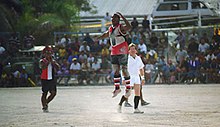

Australian rules football is played in more than 60 countries around the world with approximately 1.4 million players worldwide. By 2017 more than 26 nations (excluding Australia) had contested the Australian Football International Cup, the highest level of worldwide competition. The AFL Commission is the world governing body which manages international competition through its International Development Committee headed by Andrew Dillon. There are 3 regional governing bodies affiliated to the AFL: AFL Asia, AFL South Pacific and AFL Europe.
Australia is the only country with professional teams, now located in every state. However it is strongest (by participation rate and overall interest) in the Australian states and territories of the Northern Territory, South Australia, Victoria, Western Australia and Tasmania. The sport is moderately popular in Queensland, New South Wales and the Australian Capital Territory. These account for more than half of the population, and are part of a cultural divide known as the Barassi line, however player numbers there have grown significantly in recent decades.
In the last century it has grown as a spectator sport in many countries. It is extremely popular in Nauru where it is considered the national sport and has the highest participation rate in the world. It also has a small but growing audience in New Zealand and China where recent Australian Football League (AFL) premiership matches have been played. It has also gone through a recent revival in Papua New Guinea after several decades of decline. Since its relatively recent introduction to the South Pacific and the Indian subcontinent the code has grown rapidly particularly in Pakistan, India and Fiji. In India, the sport has attracted crowds with thousands of spectators to local matches, with the record of 20,000 being the highest outside of Australia.
While Australia still accounts for the overwhelming majority of players worldwide, the sport outside of Australia has grown rapidly since the 1980s, from just a few hundred players in a handful of clubs and countries to a record 170,744 (compared to Australia's 549,400) by 2017. Prior to the COVID-19 pandemic, the sport outside of Australia was growing at a rate of 25% per annum (compared to Australia's growth rate of 10%) with the majority of this growth coming from the Asia Pacific region.[1] Countries outside of Australia now account for almost a third of the sport's total players. Only a fraction of these players have access to a pathway to play the sport professionally, as such the majority of professional players still come from Australia. Despite these obstacles, players from all Australian states and territories have been inducted into the Australian Football Hall of Fame. In 2013 Jim Stynes was posthumously recognised as the first overseas born and raised Hall of Famer. Since the 2010s internationally developed players have begun to register matches at international, professional level or both, including Hewago Oea (Papua New Guinea/AFL) and Danielle Marshall (United States/AFLW).
Australian rules football spread throughout the world by the 1910s, however in the first major study of the early international growth of the code de Moore (2021) cites a "lack of systematic support from its heartland"[2] and the then VFL (now AFL)'s disregard for representative football, amateurism and the global growth in popularity of other football codes (particularly rugby)[3][4] as the key reasons for the code's rapid post-war decline in places like South Africa, New Zealand and the United States. Similar reasons caused the code to disappear in Queensland and much of New South Wales at the end of the 19th century.
The first tournament to feature a national side (New Zealand) was the 1908 Jubilee Australasian Football Carnival. The first recognised contest between two open level national sides was in 1976 between Papua New Guinea and Nauru in front of a crowd of over 10,000 at Sir Hubert Murray Stadium in Port Moresby which was won by PNG by 129 points.[5] There are now several large 18 or 16 a side international tournaments, the biggest worldwide being: the Australian Football International Cup (2002-), AFL Europe Championship (2010-), Asian Australian Football Championships (1999-) and 49th Parallel Cup (1999-). These all feature male and female competitions. With the cancellation of the International Cup for 2024, new open age regional representative tournaments including the Pacific Cup, Trans-Atlantic Cup and Asia Cup have been established. There are now also junior international competitions, the biggest being the Oceania Cup (2009-) in which eight pacific nations have competed, and the Pacific Cup.
The first ever full international match involving Australia was played in 1977 at under 17 level against Papua New Guinea in Adelaide, with Australia taking the honours.[6] Australia has, however, never competed at open international level. Since the 2000s it began to participate in matches against the senior teams of South Africa (2007-2010) and New Zealand (2012-2019) as the development AFL Academy side and state amateur teams have also contested these and other countries and composite World XVIII teams. In addition, indigenous and multicultural teams from Australia have competed internationally including the Flying Boomerangs in the Pacific region and a Indigenous & Multicultural (OzIM) composite amateurs team into the 2011 Australian Football International Cup.
- ^ AFL Annual Report 2017
- ^ de Moore et al. 2021, p. 228.
- ^ de Moore et al. 2021, p. 247.
- ^ de Moore et al. 2021, p. 198.
- ^ It’s PNG by 129 points. PNG Post Courier. 21 Sep 1976 Page 24
- ^ "1977-1980". Full Points Footy. Archived from the original on 10 February 2012. Retrieved 14 July 2006.